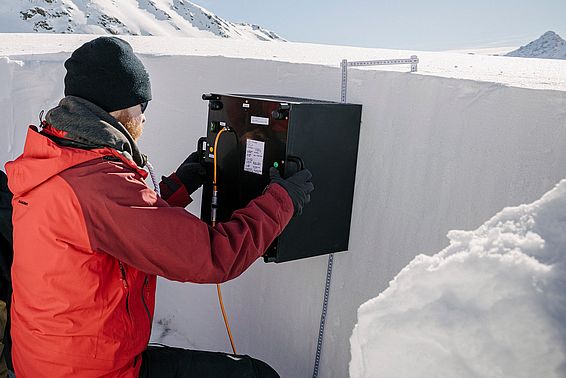30.01.2024 | Jochen Bettzieche | SLF News
The SnowImager measures snowpack structure.
Pischa resort, January 2023. Holding a black box, Lars Mewes, a physicist at the WSL Institute for Snow and Avalanche Research (SLF) in Davos, climbs into a 1.2-metre-deep hole that has been dug in the snow. He repeatedly holds this box against a wall of snow, starting at the bottom and moving to the top, for just over two minutes. Light-emitting diodes (LEDs) transmit near-infrared light that is imperceptible to the human eye into the snow. Two small cameras in the box measure how much of this light comes back. On a second pass, a panel with a slot covers the front of the device. This device is called the SnowImager and was developed by the SLF.
"We use it to determine both the size of the snow crystals and the density of the individual layers in the snow," Mewes explains. A combination of the two values indicates how the snowpack is structured. The lower the density, the deeper the light penetrates into the snow layer – and the deeper it penetrates, the greater its lateral distribution. However, the cameras only measure the portion of the light that comes back through the slit.
Mewes uses the device to detect layer boundaries in the snow, i.e. the boundaries between two layers in the snowpack structure. Individual layers differ, for example, in their densities and the type of snow crystals.
Their properties are important, among other things, for the avalanche warning service to identify weak layers. Such layers can rupture, either of their own accord or due to pressure exerted on them, for example by a skier. There is then a risk that the snow lying above the weak layer will thunder down the slope as a slab avalanche.
Members of the avalanche warning service still undertake the time-consuming work of establishing the characteristics of the snowpack manually. The SnowImager is intended to significantly speed up the process and make it objective. "We also get a better resolution," says Mewes.
It is not only avalanche warning services that will benefit. The snowpack structure also plays a role in the timing and location of flood risk, and climate researchers will acquire insights into climate change.
Today, a year later, the black box is in Antarctica. SLF technician Matthias Jaggi has taken it on an expedition lasting several months to test how it performs under harsh environmental conditions. According to Mewes, the initial results are encouraging.
There is a small catch though: the SnowImager is still bulky and weighs around three kilograms. But that is set to change. In the SLF workshops, mechanics are currently working on a new, foldable prototype that is expected to be ready this winter. The electronics for this are being developed and produced by industry partner Davos Instruments. The device will not only be easier to handle and suitable for use in the field but ready for series production.
The company is planning to produce the SnowImager on site. The project team envisages a long-term need for up to 600 units in Switzerland alone. "After all, this is the first portable and affordable device for measuring layers in the snow," says project leader Valeria Büchel. She estimates that it will probably be another two to three years before it comes onto the market.
This article first appeared in the Davoser Zeitung on 30 January 2024.
Contact ¶
Link ¶
- Picture gallery about a test day in the snow with the SnowImager
Copyright ¶
WSL and SLF provide image and sound material free of charge for use in the context of press contributions in connection with this media release. The transfer of this material to image, sound and/or video databases and the sale of the material by third parties are not permitted.
